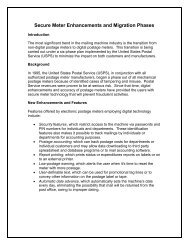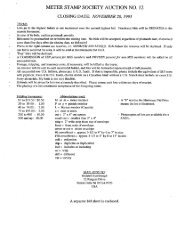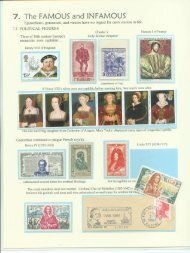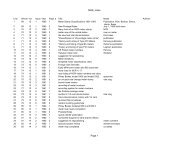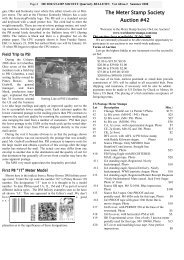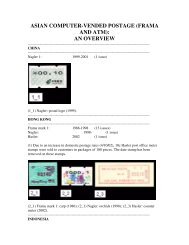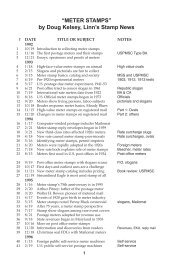GB Meter Franking - The Meter Stamp Society
GB Meter Franking - The Meter Stamp Society
GB Meter Franking - The Meter Stamp Society
You also want an ePaper? Increase the reach of your titles
YUMPU automatically turns print PDFs into web optimized ePapers that Google loves.
BRITISH STAMPS<br />
Pitney Bowes and UPF<br />
become one<br />
It will be recalled that since 1929 UPF had<br />
been the agents for Pitney Bowes. By the<br />
late 1950s the embarrassing situation had<br />
arisen whereby Pitney Bowes and UPF<br />
were competing against each other in<br />
world markets. An International Division<br />
was created in Pitney Bowes and in 1959,<br />
by shareholding arrangements, UPF became<br />
a wholly owned subsidiary of Pitney<br />
Bowes. In January 1960 a new company,<br />
Pitney Bowes Ltd, was registered in the UK.<br />
In September a letter was sent to all customers<br />
and dealers stating that from 1<br />
October 1960 the name Universal Postal<br />
Frankers was being changed to Pitney Bowes<br />
Ltd. <strong>The</strong> two specimens from Model CV<br />
machines (Fig 124) illustrate the change.<br />
<strong>The</strong> resources available to the new company<br />
meant that Roneo-Neopost was faced<br />
with a very formidable competitor. New<br />
products, not only franking machines but<br />
other associated postroom equipment which<br />
had been developed by Pitney Bowes in<br />
USA, were now more readily available in<br />
the UK market. Roneo-Neopost decided<br />
that the only speedy solution was to associate<br />
with foreign manufacturers of equipment<br />
which would enhance their product<br />
range. <strong>The</strong> first of these was with the<br />
French franking machine maker Societe<br />
pour l’Affranchissement et le Timbrage<br />
Automatique (SATAS) to make their small<br />
multivalue machine in Romford. <strong>The</strong>se<br />
appeared in the UK as Neopost Model 205<br />
in April 1963. <strong>The</strong> machine was small in<br />
size and electrically driven. It was a threebank<br />
machine with a value range 1 ⁄2d. to<br />
9s.11 1 ⁄2d. (actually, there was a smaller<br />
range model, 1 ⁄2d. to 4s.11 1 ⁄2d., but the<br />
marks are indistinguishable). <strong>The</strong> size of<br />
the frank was the smallest in Group F. A<br />
specimen mark made on perforated adhesive<br />
tape is shown in Fig 125 and the<br />
machine in Fig 126.<br />
<strong>The</strong> prefix in the specimen example is<br />
‘RN’ (presumably Roneo-Neopost) often<br />
used at this period for such specimens.<br />
<strong>The</strong> normal prefix in commercial franks<br />
was ‘J’, followed by a number of up to four<br />
figures.<br />
In 1959 it had been decided that Pitney<br />
Bowes’ British factory should be a main<br />
source of meter machines for the world<br />
market. Between 1961 and 1963 a new<br />
factory was built and equipped at Harlow,<br />
Essex. <strong>The</strong> first major project was the 5000<br />
Series of multivalue machines developed<br />
in the USA. By November 1963 the factory<br />
was ready for the official opening. <strong>The</strong><br />
Assistant Postmaster General passed the<br />
first letter through a 5300 Postage <strong>Meter</strong><br />
Machine. At that time the Post Office had<br />
not given its approval for commercial use.<br />
It was launched on 9 March 1964.<br />
<strong>The</strong>re were two models, the three-bank<br />
5335 with a value range 0/0 1 ⁄2d. to 10s.11 1 ⁄2d.<br />
(‘10’ and ‘11’ in bank 2 and the ‘10’ in<br />
bank 3 were engraved as single characters.<br />
<strong>The</strong> nil value in bank 1 (halfpenny) was<br />
‘=’. <strong>The</strong> four-bank model, 5345, had a<br />
range ∼0/0 1 ⁄2d. to 99s.11 1 ⁄2d. <strong>The</strong> symbol ‘∼’<br />
was printed by the fourth bank unless a<br />
button was depressed when it could print<br />
‘1’ to ‘9’. This was a safeguard against very<br />
high value franks being printed accidentally.<br />
Both hand-driven (Model 5400) and<br />
electrically-driven (Model 5500) bases were<br />
available. <strong>The</strong> meters were detachable<br />
from the bases for resetting at a post office.<br />
<strong>The</strong> machine numbers in the franks<br />
comprised a prefix ‘P.B.’ followed by a<br />
three-figure number and a suffix ‘A’ to ‘L’<br />
(some letters were omitted, perhaps used<br />
on machines for abroad). Fig 127 shows the<br />
mark made by a four-bank model used at<br />
Pitney Bowes Harlow factory. Fig 128<br />
illustrates the machine fitted to hand- and<br />
electrically-driven bases. <strong>The</strong> 5000 Series<br />
of machines was a replacement for the<br />
Automax.<br />
Roneo-Neopost looks abroad<br />
Over the years the Neopost Limited Value<br />
machine had been very successful and it<br />
was obviously considered worthwhile to<br />
put some effort into a redesign. In 1964<br />
the improved version was introduced as<br />
the Neopost 105. This time there were ten<br />
values: 2 1 ⁄2d., 3d., 3 1 ⁄2d., 4d., 4 1 ⁄2d., 5d., 6d.,<br />
Fig 130 Two marks from<br />
American-made Model RT<br />
machines modified to suit<br />
British currency<br />
7 1 ⁄2d., 9d. and 1s. <strong>The</strong> machine was smaller<br />
(footprint 9in×9in) than the previous<br />
model and was said to be the cheapest<br />
machine in the UK. Repeating franks was<br />
rapid and with a label dispenser could deal<br />
with parcels. <strong>The</strong> machine number in the<br />
frank had the pattern, prefix N, threefigure<br />
number, suffix ‘A’ to ‘L’ (omitting ‘I’).<br />
<strong>The</strong> mark made is shown in Fig 129.<br />
<strong>The</strong> changes in policy at Roneo-Neopost<br />
towards meter franking and postroom<br />
equipment from 1960 onwards meant<br />
more development activity at the Romford<br />
factory. Langdon, who had undertaken<br />
earlier development and who was still<br />
making the Model 305 in his factory, was<br />
aware of this and his future seemed uncertain.<br />
In 1964 Roneo made an offer for<br />
his business which he accepted and Langdon<br />
Precision Engineers became a subsidiary<br />
of Roneo-Neopost.<br />
Towards the end of 1965 Pitney Bowes<br />
Ltd modified some of the American-made<br />
Model RT machines to suit British currency.<br />
<strong>The</strong>se multivalue machines were<br />
used on collating, sealing and franking<br />
machines similar to the Model AV which<br />
used the CV meter. <strong>The</strong> meter was similar<br />
to but smaller than the 5000 Series and<br />
had only two banks.<br />
<strong>The</strong> values ranged from 0/0 1 ⁄2d. to 9 1 ⁄2d.;<br />
being decimal, 9 1 ⁄2d. was the highest value.<br />
Fig 130 shows two examples of the mark.<br />
<strong>The</strong> ‘0/’ and ‘D’ were fixtures and part of<br />
the main frank die. <strong>The</strong> town mark (of<br />
varying style) was very close to the frank.<br />
<strong>The</strong> machine number had the Prefix ‘RT’<br />
followed by a four-figure number. <strong>The</strong> ‘nil’<br />
value symbol in the first bank was either ‘-’<br />
or ‘=’. <strong>The</strong> date had an apostrophe before<br />
the year.<br />
Fig 129 Frank from the redesigned Neopost Limited Value machine—<br />
the Neopost 105<br />
G.S.M. October 2001 27





